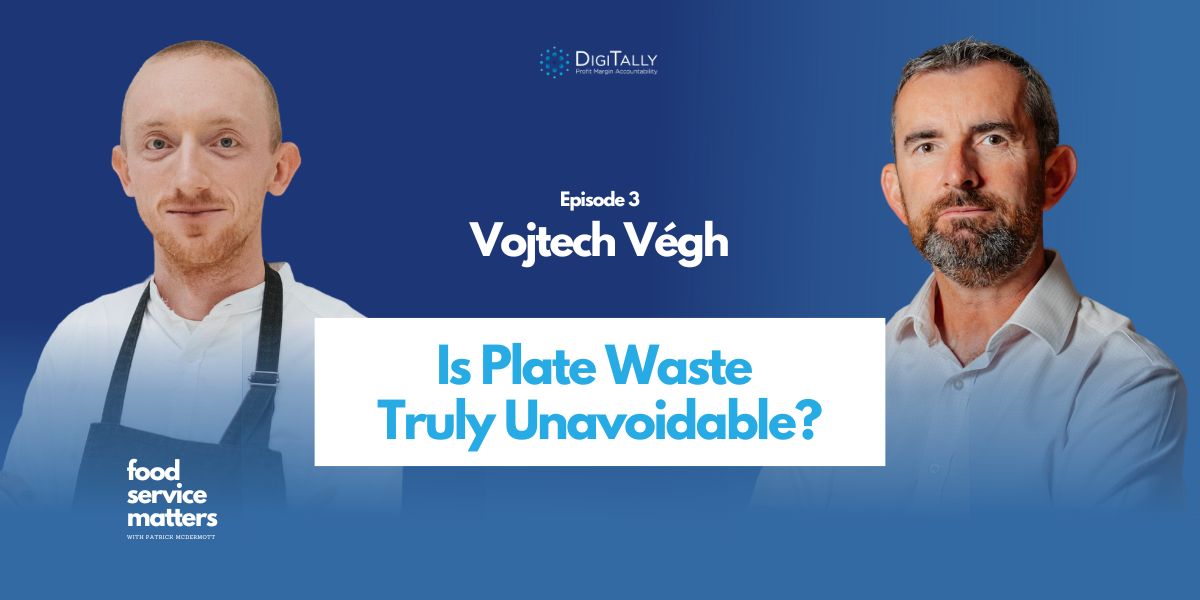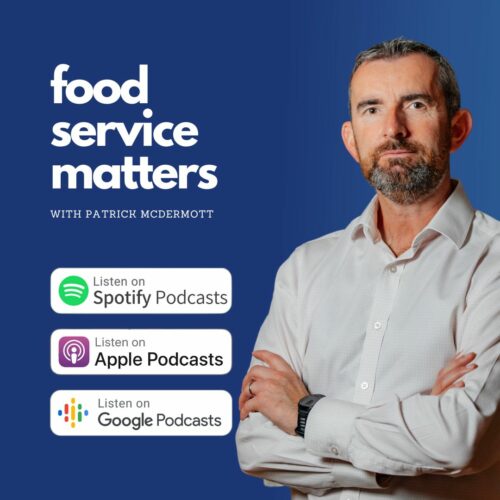Is food waste inevitable in the food service industry? We often consider it a necessary evil, but why are we buying things to then bin them?
In the food sector, many assume that plate waste, in particular, is unavoidable. After all, the customer decides whether or not to eat a certain item on the plate. But we have to ask ourselves a crucial question: is plate waste really outside our control?
In episode three of the new Food Service Matters podcast, Patrick McDermott talks with Vojtech Végh – a plant-based chef and zero-waste guru who helps restaurants around the world reduce the amount of food they throw out. Vojtech is the author of Surplus: The Food Waste Guide for Chefs.
Patrick chats with Vojtech about how to reduce food wastage in the food service sector and how a change in mindset is where it all begins.
What are “zero waste” and “plate waste”?
“Very rarely is there zero in zero waste. In reality, ‘zero’ is about trying to come as close as possible to nothing,” Vojtech explains.
“Currently, reaching absolute zero is extremely hard – borderline impossible – because you’ll always create some kind of waste. As soon as you turn your lights on, you are already creating waste somewhere. You are never going to maximise 100 per cent yield for all ingredients all the time. There are going to be accidents. There are going to be suppliers who use plastic bags. So, the idea is to come as close as possible to zero.”
This is why when thinking through your food-waste strategy, it is helpful to divide your goals into three types of waste:
- Prep waste
- Overproduction
- Plate waste
Plate waste is the food a customer leaves uneaten on the plate. It is one of the biggest challenges in reducing waste to zero but can significantly influence your ability to reach your ESG targets.
Identify the problem
According to Vojtech, step 1 is: “Measure your food waste. You will want to have all the information about what each item in the bin is – and why it is there. This applies to plate waste too. Why is it in the bin and could it be somewhere else instead? No chef is happy when items of food are regularly brought back to the kitchen.”
Next, examine the causes. “What is the biggest contributor to your plate waste? Is there a particular dish, garnish, or another item that is constantly being wasted? This is very important to manage adjustments.”
Communicate
Communication is at the heart of an environment that encourages the implementation of changes needed to cut waste. Team members who trust each other can greatly impact the reduction of plate waste.
Front-of-house staff can help to identify the problems and communicate them. Vojtech says, “In the case of plate waste, the work doesn’t stop in the kitchen. Front-of-house are the ones who receive the plate. They see exactly what’s left on it. They can give vital feedback.”
They also play an essential role in reducing plate waste. “Plate waste can occur for a variety of reasons. Perhaps a customer was surprised by the flavours – maybe they weren’t well described or communicated on the menu or by the servers. For example, if someone doesn’t like garlic, they won’t be happy by receiving a vegetable covered in garlic oil, especially if that hadn’t been communicated to them. That person will then probably create plate waste.”
Vojtech adds, “Management and kitchen staff must communicate with front-of-house so that they’ll know how to talk to guests about the food. They’ll be able to explain what ingredients are used and therefore address likes, dislikes, and – importantly – allergies. They’ll be able to adjust customers’ expectations of the dishes.”
Target your plate waste culprits
Once you have measured and gathered your information, it is time to address your waste sources and make changes to your menu and procedures.
What are some of the big causes of plate waste, according to Vojtech, and what can you do to tackle them?
Garnish
“If a garnish doesn’t compliment the dish itself, customers are unlikely to eat it. There are so many restaurants that do that. Instead, do not put unnecessary garnish on a plate, especially if it is constantly being wasted.”
Portions
“In some cases, plate waste is due to overly large portions. Sometimes, there are too many vegetables or too big a piece of meat for a customer to comfortably eat in a three-course meal. Chefs should see this when the plates come back, and front-of-house can communicate better too.”
Complimentary snacks
“Often, restaurants hand out bread baskets at the beginning of a meal without the customer asking for it. Then, no one touches the bread and it just goes straight into the bin. Think about how much time you could save in the kitchen by not preparing those items.”
No more plate waste!
Vojtech emphasises that the whole team must be on board for the zero-waste journey to succeed: “The effort to reduce and reuse food waste runs through the entire company. It doesn’t end in the kitchen; it starts in the kitchen. Remember, it goes through every touchpoint that the customers have with the company.”
To listen to Patrick’s full interview with Vojtech, check out the Food Service Matters podcast.
If you want to measure and understand your kitchen wastage so that you can begin your journey to zero waste, this is where to start. Patrick is CEO of stocktaking app DigiTally, an intuitive stock management system that keeps your whole business up to date, helps reduce food waste, and saves time. Let’s talk! Click to book a 30-minute chat with Patrick and ask about setting up a demo.




